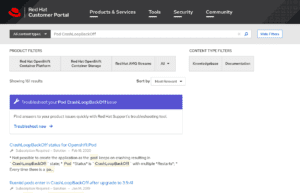Customer Stories




Support Red Hat customers’ desire to self-solve problems using resources available in the knowledgebase, download product software or installers, or quickly troubleshoot error messages via Red Hat’s award-winning customer support portal.
Leveraging Fusion signals and machine learning models, detect the intent behind users’ queries and provide search results that supply the documents and assets necessary to reach their objectives.
Over a two-month period of 2020, support case deflection rate was 7.39%, with over 2,700 support cases deflected. Compared to October 2018, when the deflection rate was just 1.8%, this amounts to an increase of 311% in the self-solve rate.
Customers prefer to fix their own problems. That’s what enterprise technology company Red Hat discovered by A/B testing their customer support homepage, offering a self-service option to some visitors and not to others. “There was an increase in traffic that confirmed customers are really motivated to self-solve, and we saw a 7% decrease in support case creation for customers who were given the self-solve homepage,” says Manikandan Sivanesan, Principal Software Engineer for Red Hat’s search platform.
Red Hat provides open-source software products and solutions to a global customer base, including over 80% of the Fortune 1000. The company is built on a subscription-based business model, which includes access to its award-winning customer support portal.
Customers visit the portal to solve problems using resources in the knowledgebase, download product software or installers, troubleshoot an error message, or open a new support case. The portal offers product upgrades, security advisories, certified vendor and hardware information, and product documentation, FAQs, and “how to”s customized to each of Red Hat’s over two dozen products. A number of available lab apps allow customers to configure their systems and check for any vulnerabilities. In return for finding their own solutions via the portal, customers expect a fast response, the same benefit they’d get from an ATM or self-checkout.
Promoting self-service is a win/win/win. Customers get the answers they want quickly; support engineers, once burdened with mundane cases, can focus on outlier requests that require engineering acumen to resolve; and, often, operational costs see a marked decrease. According to the Harvard Business Review, “self-service offers companies a tantalizing opportunity to reduce spending, often drastically. The cost of a do-it-yourself transaction is measured in pennies, while the average cost of a live service interaction (phone, e-mail, or webchat) is more than $7 for a B2C company and more than $13 for a B2B company.“
So how did Red Hat streamline its data access and varied customer requests to create one of “The Ten Best Web Support Sites,” according to The Association of Support Professionals, for nine years running? By providing an intuitive UX and functional, relevant search using Lucidworks Fusion.
To satisfy their customers’ inclinations, Red Hat made self-service the default and integrated a troubleshooting experience into their standard case creation process.
Leveraging a machine learning model, Red Hat detects the intent behind a user’s search query and drives them to the UI that best supports their resolution efforts. Does the customer want to learn about product usage or troubleshoot a problem? If the model infers that the user is searching an error code, he is sent to a dedicated troubleshooting tool designed to make the experience intuitive.

In order to apply that same intuition to search results, feedback from both customers and support engineers is used to promote relevancy.
Customer feedback comes from clickstream data extracted from the subscriber’s behavior in the support portal. What article did they click, what pages did they visit, how long did they stay on each page, etc: all of this data is captured and aggregated using Fusion signals.
Support engineer feedback comes when a customer chooses to open a support case rather than self-solve. The support engineer records support case diagnostic data in a structured way, then attaches any of the over 600k documents in the knowledgebase used to solve the case to the record.
Queries are run against the support case collection, and when a similar issue is identified, the solution linked to the previously solved case is surfaced. Not only does the original support-center customer benefit from the solution, but any subsequent support-center customer benefits, as well as the self-service customer whose keywords trigger the resolved case.
Applying the popularity of the knowledge content, i.e. the number of cases a document resolved, as a signal measure, Fusion appropriately boosts or buries documents as part of the query pipeline. A time decay function is used so that a document that helped resolve a case a year back is boosted less than a document used to resolve a similar case today.
Coupling Fusion with Word2Vec, a powerful modeling technique commonly used in natural language processing, allows word relationships to be identified. This is useful when customers search for upstream components of Red Hat’s open-source products rather than the products themselves. Word2Vec solves a customer searching for “Kubernetes” when they are actually looking for information about Red Hat’s OpenShift, or a search for “Karaf” when they are looking for tips on using Fuse.
With automation and machine learning improving relevancy, scaling to the increased support volume generated by Red Hat’s ever-growing product portfolio is made possible.
Customers who are motivated to find a quick solution are finding it on Red Hat’s customer portal. Click depth averages 2.2 and click-through rates average 58.4%.
Over a two-month period of 2020, more than 2,700 or 7.39% of support cases were deflected. Compared to October 2018, when the deflection rate was just 1.8%, this amounts to an increase of 311% in the deflection rate.

“When faced with any questions about product usage or errors, customers need the option to turn to knowledge-based platforms. If these provide accurate and relevant content, customers will use them willingly rather than reaching out to a service representative. It puts them in the driver’s seat and gives them control,” says Sivanesan.